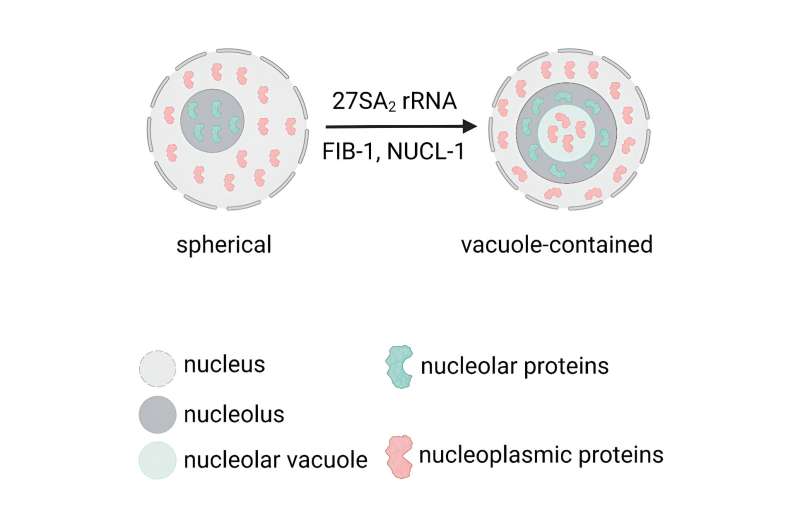This article has been reviewed according to Science X's editorial process and policies. Editors have highlighted the following attributes while ensuring the content's credibility:
fact-checked
peer-reviewed publication
proofread
Researchers reveal composition and regulatory mechanism of the nucleolar vacuole in C. elegans

A team led by Prof. Guang Shouhong and Prof. Feng Xuezhu from the University of Science and Technology (USTC) of the Chinese Academy of Sciences (CAS) revealed, for the first time, the composition and regulatory mechanism of the nuclear vacuole in C. elegans. The study was published in Cell Reports.
The nucleus contains a prominent organelle called the nucleolus, which is primarily responsible for the assembly and production of ribosomes, which are essential cellular structures involved in protein synthesis. Increasing evidence indicates that the nucleolus is a condensed biomolecular structure that forms through phase separation; it displays three or two internal phase-separated subcompartments in mammalian cells and C. elegans, respectively.
However, there is a highly conserved central region, called the nucleolar cavities or vacuoles (a similar nucleolar vacuole [NoV] has been observed in mammalian cells), present in the nucleoli of various plants and animals.
Using differential interference contrast (DIC) microscopy and fluorescent microscopy, the team visualized the nucleolar structure of C. elegans. and found that there were two kinds of nucleoli: spherical and vacuole-contained nucleoli. Candidate-based RNAi screening was used and it was found that knockdown of a distinct class of ribosomal proteins of the large subunit (RPLs) reshaped spherical nucleoli to vacuole-contained nucleoli, accompanied by abnormal accumulation of 27SA2 rRNAs.
Another two highly conserved nucleolar proteins with internal disordered sequences, NUCL-1 and FIB-1, are also required for the formation of NoVs. Collectively, these findings imply a strong correlation between the organization of the nucleolus and the processing and maturation of rRNA.
The researchers found that the appearance of NoVs is dynamic in C. elegans, which means the presence of NoVs varies in different states during development. In addition, the researchers also speculated that the expression and processing of rRNAs are differentially regulated across different cell types and throughout development and aging, which would induce the formation of cell-type-specific nucleolar structures and the change of NoVs during germline maturity and aging of the animals.
More information: Demin Xu et al, rRNA intermediates coordinate the formation of nucleolar vacuoles in C. elegans, Cell Reports (2023). DOI: 10.1016/j.celrep.2023.112915
Journal information: Cell Reports
Provided by University of Science and Technology of China




















